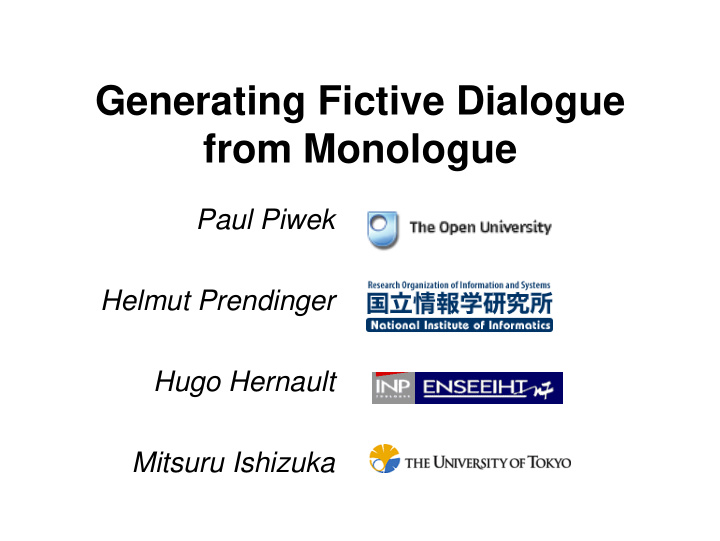



Generating Fictive Dialogue from Monologue Paul Piwek Helmut Prendinger Hugo Hernault Mitsuru Ishizuka
What is fictive dialogue? � Historical precedent: Plato, Erasmus, Galileo, …, Hofstadter … � Common on Radio, TV, Theatre, Games, …
Why Fictive Dialogue? A means for presenting information which complements monologue diagrams and pictures. � successful for entertainment � allows an author to introduce different points of view � can be effective in education and persuasion
Why Fictive Dialogue? � Students write more in free recall test (Craig et al., 2000) � Students ask more and “deeper” questions in a transfer task (Craig et al., 2000) � There is more discussion amongst students and less irrelevant banter (Lee et al., 1999) � Student learning is at least as good as in monologue condition (Cox et al., 1999) � Team of two agents having a conversation more persuasive than a single agent directly addressing a user (Suzuki & Yamada, 2004)
Generating Fictive Dialogue
Automated Generation of Fictive Dialogue
Generating Fictive Dialogue � Approaches: � From data to script (Piwek & Van Deemter, 2007 RLaC ; Van Deemter et al., 2008 AIJ )
Database (Java JAM) FACT attribute "car-1" "horsepower“ "80hp"; FACT impact "car-1" "horsepower“ "sportiness" "pos"; FACT importance "horsepower" "sportiness" "high"; FACT role "Ritchie" "seller"; FACT role "Tina" "buyer"; FACT trait "Ritchie" "politeness" "impolite"; …
Generating Fictive Dialogue � Approaches: � From data to script (Piwek & Van Deemter, 2007 RLaC ; Van Deemter et al., 2008 AIJ ) � From text to script (T2D) Piwek et al. 2007 IVA07 Patient information leaflets
The T2D System � Input : monologue (text) � Output : dialogue (text/presentation) � Information/meaning conveyed by text is preserved. � Coherence relations in the text are preserved.
T2D: System Architecture Rhetorical RST Tree to DialogueNet Transformation Structure Theory DialogueNet Re-Generation to MPML3D (RST) Mapping Personalized Dialogue Personalized Dialogue Text RST Multimodal Structure DialogueNet Script Tree Dialogue (DialogueNet) (MPML3D) Slide design inspired by J. Cassell on BEAT
RST Tree to DialogueNet Question Answer Question Answer MEANS ANSWER (MEANS) Use chopsticks. To eat Japanese food use chopsticks How can I eat Japanese food? Layman Expert (Role assignment)
T2D: Input Patient Information Leaflet (from PIL corpus) […] Do not take Klaricid tablets if you are allergic to clarithromycin. Klaricid does not interact with oral contraceptives. […]
RST Tree to DialogueNet CONDITION 1) Nucleus in Imperative Form (“Take Klaricid tablets” / “Do not take Klaricid tablets”) Q P CONDITION( P ,Q) & imperative(P) ⇒ Layman: Under what circumstances should I P* ? CONDITION( P ,Q) Expert: If Q. 2) Nucleus in Declarative Form with Modal Auxiliary (“You should take Klaracid tablets”) CONDITION( P, Q) & declarative-modal-aux(P) ⇒ Layman: Under what circumstances flip( P* ) ? Expert: If Q. 3) Alternative Mapping CONDITION( P, Q) ⇒ Layman: What if Q*. Expert: Then P . P* is P[I:=you,you:=I,my:=your,your:=my,mine:=yours,yours:=mine]; flip(X) inverses subject and auxiliary.
RST Tree to DialogueNet ANSWER (ELABORATION) ANSWER (INDUCED ‐ DIALOGUE) Induced ANSWER (CONDITION) Dialogue ANSWER (Y/N) Klaricid does not interact with Under what If you are allergic oral circumstances to clarithromycin. Do you want Yes, please. contraceptives. should I not take to know Klaricid tablets? more about Klaracid? Layman Expert Expert Layman Expert
MPML3D <MPML3 D version=" 1.0 "> <Head>…</Head> <Body sta rtImmediately=" Demo1 "> - <Task name=" Demo1 " priority=" 0 "> - <Sequential> - <Parallel > <Action name=" yuukiSpeak "> yuuki.speak(“Under what circumstances shouldn’t I take Klaricid tablets? ") </Action> <Action minor=" true " startOn=" yuukiSpeak[1].begin " stopOn=" yuukiSpeak[9].end "> yuuki.turnHead(-10,0.2,10,0.3) </Action> <Action minor=" true " startOn=" yuukiSpeak[1].end " stopOn=" yuukiSpeak[9].end "> ken.turnHead(10,0.2,10,0.2) </Action> </Parallel > <Action> ken.turnHead(10,0.2,0.3,0.2) </Action> - <Parallel > <Action name=" kenSpeak "> ken.speak(“ If you are allergic to clarithromycin. ") </Action> <Action minor=" true " startOn=" kenSpeak[1].end " stopOn=" kenSpeak[6].end "> ken.turnHead(10,0.2,10,0.2) </Action> <Action minor=" true " startOn=" kenSpeak[2].begin "> ken.gesture("BEAT_SINGLE", 0.2, 0.6) </Action> <Action minor=" true " startOn=" kenSpeak[2].begin "> yuuki.gesture("breath") </Action> </Parallel > … </Sequential> </Task> </Body> </MPML3 D>
Preliminary Evaluation � Ongoing work: 9 relations implemented so far. � DAS evaluation � Random sample of 100 conditionals; � correct 61%, failure 39%; � Details failure: 19% OCR error; 19% No mapping; 22% DAS crashes; 40% incorrect analysis (15.6% overall). � Mapping evaluation � Fresh random sample of 100 conditionals; � Manually annotated in terms of RST; � Mapping 92% correct; 8% incorrect (4% machinese syntax error; 4% mapping rules did not cover a specific case).
Current and Future work � Mapping nested rhetorical relations (Hernault et al., 2008 IVA08 ) � Robustness/domain-independence (RST Discourse Treebank, …) � Empirical foundations: building a parallel monologue-dialogue corpus � Question Generation Shared Task and Evaluation (www.questiongeneration.org)
Recommend
More recommend